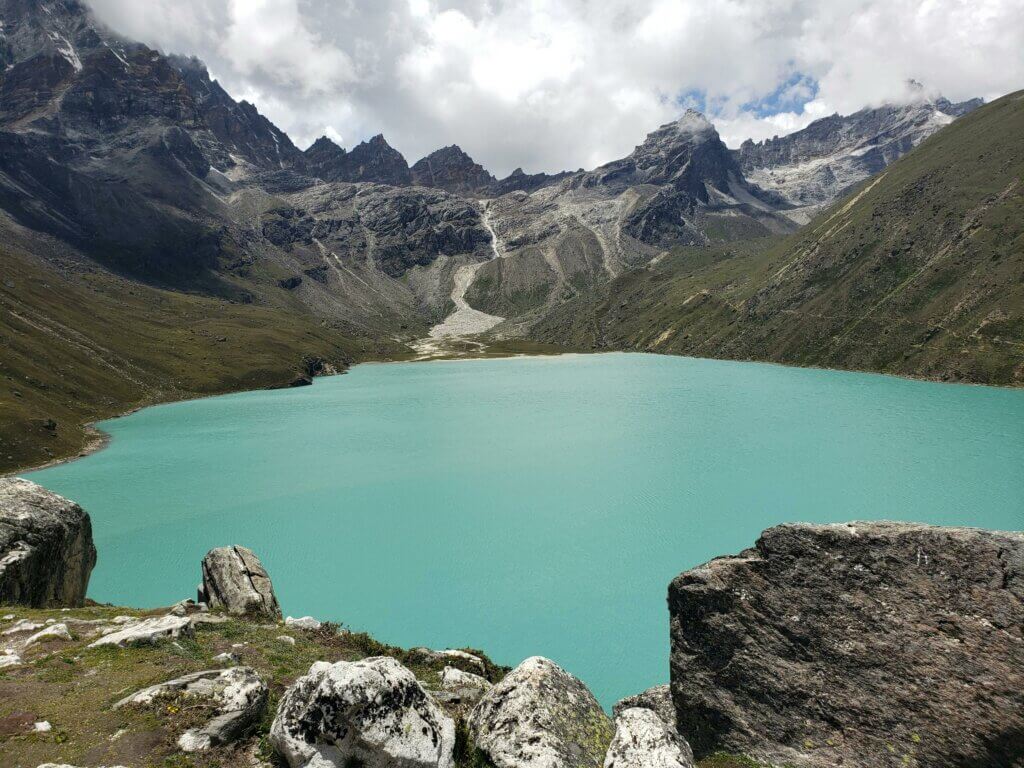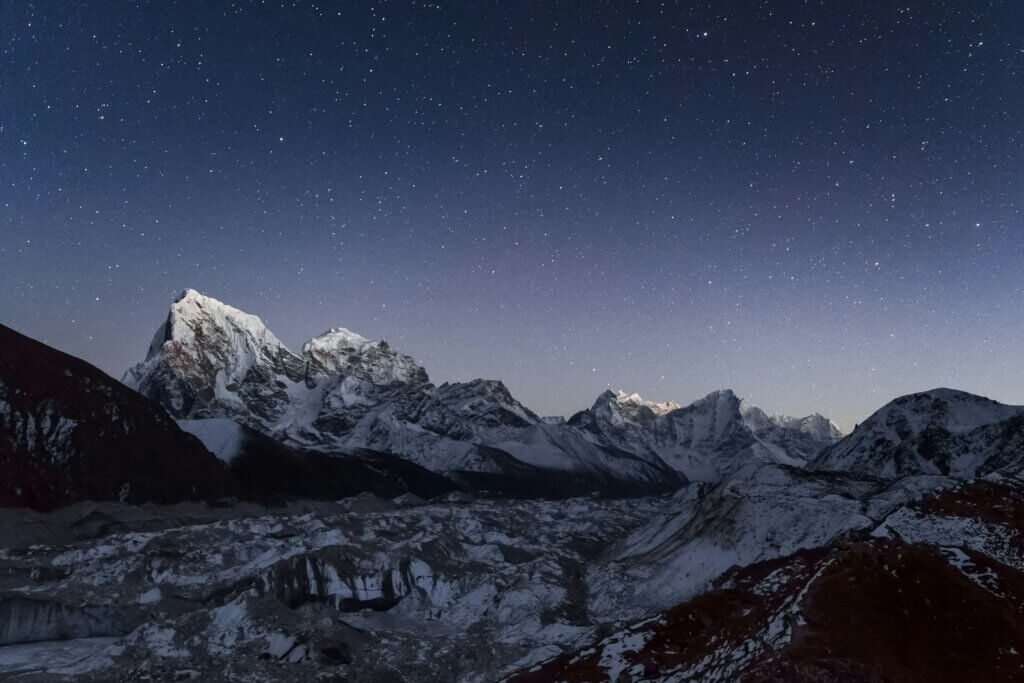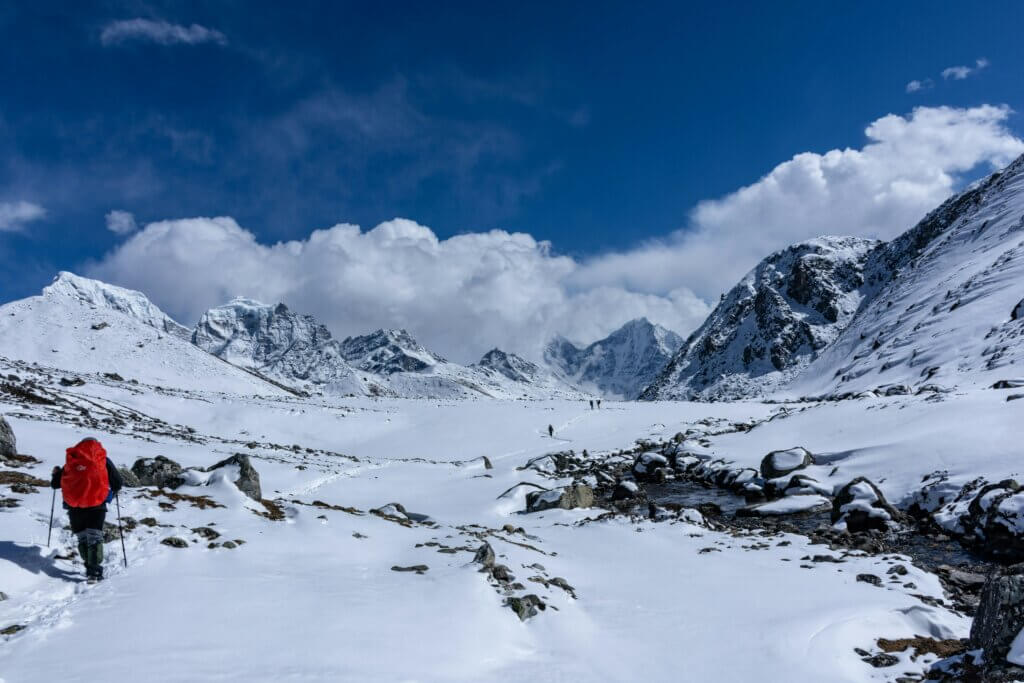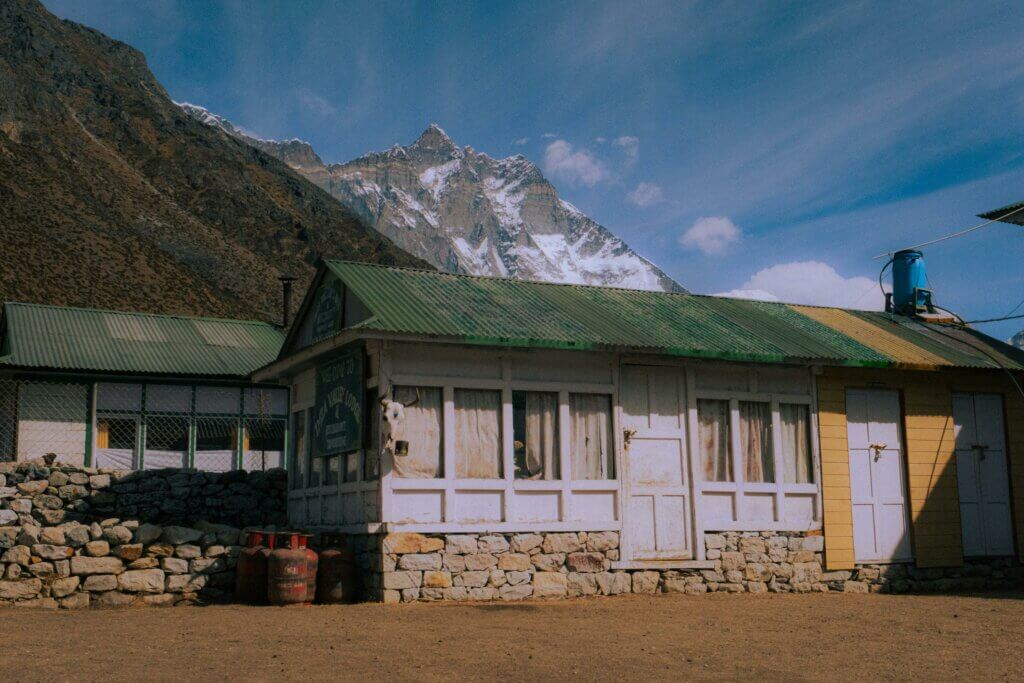Gokyo Lake, which is situated at an altitude of 4,700–5,000 m above sea level, is one of the world’s highest freshwater lakes. Trekking to this Gokyo Lake is not only for religious or spiritual travelers, but also a famous trekking destination for foreign travelers. Every year, more than 7,000 tourists visit here, and the number of visitors is expected to increase in the coming years, according to the Nepal Tourism Board.

This magical place is also a part of Sagarmatha National Park. The beauty of the pristine turquoise Gokyo lakes will attract whoever visits here. This palace can be reached by a combined trek with the Everest Base Camp Trek or by direct trekking to Gokyo Lake as well. Even some tour Operators like Eco Nepal Trekkers offer helicopter charter facilities for visitors who wish to visit in a very short period.
Further hiking from the Gokyo Lake, you can reach the Gokyo Ri, which is a great spot to see the four 8,000-metre Mount Everest, Lhotse, Makalu, and Cho Oyu. Normally, a person who has good stamina can reach Gokyo Ri from Gokyo Lake in 2 hours. The trekking distance from Gokyo Lake to Gokyo Ri is 1.7 km.
Let’s understand what things you need to know before trekking to the Gokyo Lake Trek.
Why Gokyo Lake Holds Religious Significance for Hindus and Buddhists
The Gokyo Lake is highly respected by both Hindus and Buddhists, with around 500 Hindus taking a bath there during Janai Purnima, a festival that celebrates the sacred thread. At the western edge of the lake is a temple dedicated to Hindu deities such as Lord Vishnu and Shiva.
The location is revered as the dwelling place of Naag Devata, also known as the Snake God. Wetland birds find refuge in the lake thanks to the belief that there is “no harm” to the birds.
How To Reach the Starting Point of the Gokyo Lake Trek
The common starting point of the Gokyo Lake trek is Lukla, and to reach this starting point, visitors need to take a domestic Lukla flight from Kathmandu Airport. The flight distance from Kathmandu to Lukla airport is 138 km, and the flight duration will be around 30-35 minutes.
An alternative to flying into Lukla is to travel by road. For this, you need to hire private vehicles like jeeps to reach Jiri, Salleri/Phaplu, and then trek to reach Lukla. Remember that there is no direct road connection from Kathmandu to Lukla.
Are You a Solo Traveler and Want to Reach Gokyo Lake Alone?
If you’re thinking about trekking to Gokyo Lake solo, it’s important to know that solo trekking is generally not allowed in most trekking areas of Nepal, including Gokyo Lake. To remain safe and follow the rules of the area, it is necessary to engage the services of a guide. Check this website for more information about which places you cannot trek alone:https://ntb.gov.np/latest-travel-updates.
The Best Time to Trek Gokyo Lake Trek
Your trekking experience in the Khumbu region and to Gokyo Lake can be greatly influenced by the season you choose. Pre-monsoon (spring) and post-monsoon (fall) are usually the finest seasons to hike. You’ll be treated to gorgeous views, steady weather, and clearer skies at these times.
Majestic Mount Cholatse and the vast Ngozumpa Glacier under a stunning night sky in Gokyo Valley, Himalayas, Nepal.

Spring (March to May)
Spring is a great time to go to Gokyo Lake because the weather and the environment become vibrant again.
- Temperature: Average daytime temperatures hover around 11°C to 16°C (50°F to 59°F) in lower altitudes, while higher altitudes remain cooler.
- Snow Melting: The snow starts to melt away, revealing stunning landscapes adorned with blooming flowers.
- Visibility: One of the highlights of trekking in spring is the clear visibility it offers. From this vantage point, you can take in the majestic Mount Everest and the picturesque Gokyo Ri peak.
- Flora and Fauna: Spring’s emergence into life includes not just the greenery but also a higher chance of spotting wildlife. You’ll enjoy a vibrant environment with blossoming rhododendron forests, making the trails even more beautiful.
Autumn (September to November)
Autumn is another of the best trekking seasons, offering slightly cooler temperatures and exceptional visibility.
- Temperature: During Autumn, temperatures can range from 6°C to 12°C (43°F to 54°F) during the day, dropping significantly at night.
- Post-Monsoon Clarity: The monsoon rains typically end in August, clearing the haze and dust from the air. This results in crisp blue skies that present unparalleled views of the Himalayas.
- Trails and Culture: Autumn is also a festive time in the region, with local festivals adding cultural richness to your trekking experience. The trail path is less crowded compared to spring, allowing for a more intimate experience with nature.
Winter (December to February)

Winter trekking is not ideal for Gokyo Lake due to harsh weather conditions, with heavy snowfall, freezing temperatures, and poor visibility.
Monsoon (June to August)
During the monsoon period, there is a lot of rain, which causes the trails to become slippery, increases the risk of landslides, and reduces visibility because of clouds.
Required Permit For The Gokyo Lake Trek
To protect the natural environment and manage tourism in the Khumbu Region, the Nepalese government requires trekkers to obtain certain permits for the Gokyo Lake Trek.
Trekkers’ Information Management System (TIMS) Card
The TIMS card, which is issued by the Nepal Tourism Board(NTB), is necessary for trekkers planning to hike in Nepal, including the Gokyo Lake Trek. It is designed to ensure the safety of trekkers and assist in rescue operations if needed.
Cost of TIMS Card
- Individual Trekkers: Approximately NPR 2,000 (around USD 15)
Group Trekkers: Approximately NPR 1,000 (around USD 8)
Note: Now people can pay for a TIMS Card online as well. For filling out the form and for more details, click here: https://tims.ntb.gov.np/login.
How to Obtain a TIMS Card
You can apply for a TIMS card at the Nepal Tourism Board office in Kathmandu. You will need to provide a passport-sized photo, a copy of your passport, and details about your trekking itinerary. For direct click here: Google map.
Sagarmatha National Park Permit
Since the Gokyo Lake Trek falls within the Sagarmatha National Park, trekkers are required to obtain an entry permit for this UNESCO World Heritage Site. The park is home to Mount Everest and a rich diversity of flora and fauna.
Cost of Sagarmatha National Park Permit
- Foreigners: NPR 3,000 (around USD 25)
- SAARC Countries: NPR 1,500 (around USD 12)
How to Obtain a Sagarmatha National Park Permit
The Sagarmatha National Park entry permit can be purchased at the entrance of the park at Monjo or at the Nepal Tourism Board office in Kathmandu.
Gokyo Lake Trek Itinerary Outline
The Gokyo Lake Trek can be completed normally in an average of two weeks. The itinerary of Gokyo Lake can be changed according to the trekker’s interests and desires. Below is the standard itinerary of the Gokyo Lake trek from Eco Nepal Trekkers.
You can know the day-to-day trekking distance and trek duration.
- Day 01: Arrival in Kathmandu
- Day 02: Fly from Kathmandu to Lukla (2,850 m), 35 mins; Trek to Phakding (2,651m), 3-4 hrs
- Day 03: Trekking from Phakding to Namche (3,440m), 5-6 hrs
- Day 04: Acclimatization Day in Namche
- Day 05: Trekking from Namche Bazaar to Dole (4,110m), 6 hrs
- Day 06: Trekking from Dole to Machhermo (4,470m), 4 hrs
- Day 07: Trekking from Machhermo to Gokyo (4,800m), 4 hrs
- Day 08: Trekking from Gokyo to Machhermo (4,470m), 4 hrs
- Day 09: Trekking from Machhermo to Namche (3,440m/11,286) 5-6 hrs
- Day 10: Trekking from Namche Bazaar to Lukla (2860m), 6 hrs,
- Day 11: Fly from Lukla to Kathmandu (1,350m), 35-40 mins
- Day 12: Sightseeing in Kathmandu
- Day 13: Final Departure
Note: For more details about the itinerary, check here: Gokyo Lake Trek Itinerary. If you want to combine with Everest Base Camp, then click here: EBC via Gokyo Lake.
Gokyo Lake Trek Difficulty
The trek is generally classified as moderately challenging, covering around 70 kilometers (43 miles) over 10 to 12 days, depending on the schedule. Trekkers usually go to altitudes above 5,350 meters (17,500 feet) at Gokyo Ri, which might lead to difficulties from altitude sickness. Coupled with uneven terrain, steep ascents, and irregular weather conditions that might quickly shift in the highlands, trekkers must be in good physical form and acclimate correctly during the route.
How To Prepare Physically For the Gokyo Lake Trek
Building Endurance:
Endurance is one of the most important physical requirements for the Gokyo Lake Trek. Daily trekking sessions last five to six hours, and the trek might last up to two weeks. Do cardiovascular exercises like swimming, riding, and jogging to get ready. Five days a week, try to get in at least 30 to 60 minutes of aerobic exercise. To replicate the differing paces you could experience on different days of the walk, use interval exercises.
Strength Training:
To carry a heavy backpack and navigate challenging trails, you must strengthen your upper body, legs, and core. A thorough fitness program that includes exercises like squats, lunges, step-ups, and deadlifts will help you develop the strength and endurance needed for trekking. Exercises that focus on your shoulders and core should also not be overlooked because these muscles are essential for balance and stability when traveling uneven terrain while carrying a heavy backpack.
Practice Hiking:
Nothing beats training that mimics the actual trek. If possible, try to hike in mountainous terrain with a loaded backpack. This experience will not only condition your body but also prepare you mentally for the challenges ahead. Aim to progressively increase the weight in your backpack and the difficulty of your hikes as you approach your departure date.
Flexibility and Recovery:
You may increase your flexibility and lower your risk of injury by implementing mobility and stretching exercises into your everyday routine. You can increase your flexibility and speed up your recovery by doing exercises like yoga or dynamic stretching. Rest days should be prioritized because they are essential for endurance building and muscle repair.
Importance of Acclimatization During the Gokyo Lake Trek
As you prepare physically, it’s equally important to focus on acclimatization to minimize the risks associated with altitude sickness, which can occur above 2,500 meters (8,200 feet).
- Gradual Ascent: The Gokyo Lake Trek follows a gradual ascent schedule designed to allow trekkers time to acclimatize. Consider starting your acclimatization at a lower altitude and allowing your body to adjust. For instance, several days spent in Namche Bazaar (3,440 meters or 11,286 feet) are critical as this village serves as the gateway to the Everest region and offers ample opportunities to explore and acclimatize.
- Hydration and Nutrition: Maintaining proper hydration is important when traveling to high elevations. To stay adequately hydrated, strive to consume at least 3 to 4 liters of water each day, and consider incorporating electrolyte supplements into your routine. A balanced diet that includes a balance of complex carbohydrates, lean proteins, and nutritious fats will help fuel your body for extended periods of physical activity, such as hiking.
- Listen to Your Body: Monitor your body’s response as you climb higher. Be aware of the warning signs, such as headaches, queasiness, lightheadedness, and exhaustion, which can signal the onset of altitude sickness. Keep your fellow trekkers and guide informed about your well-being, and be prepared for the worst.
- Altitude Training: If you have access to altitude training facilities or can spend time at high elevations before your trek, take advantage of those opportunities. This form of training can enhance your body’s ability to cope with low oxygen levels.
Packing List For Gokyo Lake Trek
Clothing
- Warm down jacket
- Fleece or wool sweater, thermal inner layers
- Lightweight trekking pants
- Waterproof jacket and pants
- Gloves, hat, and scarf
- Trekking socks and extra pairs
Footwear
- Strong trekking boots (well broken-in)
- Lightweight shoes for camp/lodges
Gear & Accessories
- Backpack (30–50L)
- Sleeping bag (good for -10°C or lower)
- Trekking poles
- Sunglasses and sunscreen
- Headlamp with extra batteries
- Water bottles or a hydration system
- Water purification tablets
Toiletries & First Aid
- Toothbrush, toothpaste, and soap
- Wet wipes and tissues
- Lip balm and moisturizer
- Basic first aid kit (bandages, painkillers, etc.)
- Altitude sickness medicine (consult your doctor)
Other Essentials
- Snacks (energy bars, dry fruits)
- Power bank for charging devices
- Lightweight towel
- Passport and permits
Food on the Gokyo Lake Trek
The dining experience during the Gokyo Lake Trek is as much about the food as it is about the ambiance. Eating with fellow trekkers in cozy wooden lodges or at outdoor tables with stunning mountain views creates an unforgettable atmosphere. It’s a time to share stories, laugh, and forge new friendships over a shared love for adventure and good food.
One of the highlights of trekking in Nepal is the opportunity to savor its traditional cuisine. Throughout the Gokyo Lake Trek, you’ll encounter various teahouses and lodges serving delicious and hearty meals.
The most common dishes include:
- Dal Bhat: This classic Nepalese dish consists of lentil soup (dal) served with rice (Bhat), pickles (achar), and sometimes vegetables or meat. It is not only nutritious but also provides the necessary energy for trekking. In general, you can say Nepali Food Dal Bhat Tarkari.
- Momos: Trekkers often eat these meat or vegetable-filled dumplings as a snack. They frequently come with a zesty dipping sauce, which gives them a fun taste.
- Thukpa: A warming noodle soup that is perfect for chilly evenings. Thukpa can be made with meat or vegetables and is loaded with local spices, making it a favorite among hikers.
- Fried Rice and Noodles: Quick and filling options that are widely available in the teahouses. Perfect for those craving a bit of comfort food after a long day of trekking.
- Nepalese Tea and Coffee: After a day on the trails, a cup of sweetened Nepalese tea (chai) or freshly brewed coffee can be incredibly refreshing. Be sure to indulge in these local beverages while soaking in the serene views.
Dietary Considerations
Many teahouses cater to various dietary restrictions, including vegetarian and vegan options. If you have specific dietary needs, make sure to communicate them when you arrive at the teahouse, and the friendly staff will do their best to accommodate you.
Accommodation on the Gokyo Lake Trek

The accommodation along the Gokyo Lake Trek primarily consists of teahouses—simple lodges that provide a welcome respite for trekkers. These teahouses usually offer basic amenities, including:
- Comfortable Rooms: Most teahouses offer twin-shared rooms with simple wooden beds and bedding. While the facilities may be basic, the warmth and tranquility of the surroundings compensate for this, providing a unique experience.
- Shared Bathrooms: You’ll find that most teahouses have shared toilets and washroom facilities. Some may offer hot showers for an additional fee.
- Warm Meals and Snacks: Every teahouse generally has an on-site kitchen where traditional meals and snacks are prepared freshly, ensuring that you have sufficient nutrition after a day of trekking.
Prices and Booking Of Accommodation
Teahouse prices can vary based on location, availability, and season. High-demand areas might charge slightly more, especially during peak trekking seasons (spring and autumn). It’s advisable to book accommodations in advance if traveling during these times, although many trekkers choose to arrange their stays as they go.
Camping Option
For those seeking a more rugged experience, some trekkers opt for camping along the route. This requires more planning and logistics, including hiring guides and porters and preparing food. While camping can offer spectacular solitude and closer ties to nature, teahouses are generally more convenient and accessible for the average trekker.
Expert Tips: Gokyo Lake Trek Safety Considerations
A once-in-a-lifetime experience is trekking to the breathtaking Gokyo Lakes in the Nepalese Himalayas. An almost otherworldly experience is created by the alluring blue lakes encircled by majestic peaks. However, the Gokyo Lake trip has its own set of difficulties, much like any other high-altitude adventure. A trip that is both safe and pleasurable can be greatly improved if you become aware of potential risks and emergency procedures. Awareness of Potential Hazards
- Altitude Sickness: One of the most serious concerns when trekking at high altitudes, such as the Gokyo Lake trek (which reaches elevations above 4,700 meters), is altitude sickness. The decreased amount of oxygen levels can lead to symptoms such as headaches, nausea, fatigue, and difficulty sleeping. Here are a few key points to keep in mind:
- Gradual Ascent: Acclimatization is critical. Give yourself enough time to climb the mountain so that your body can acclimate to the new elevation.
- Hydration: Drinking plenty of water is essential. Dehydration can exacerbate symptoms of altitude sickness.
- Recognize Symptoms: Be attentive to how you feel. If you or someone in your group experiences symptoms, it’s crucial to stop ascending and descend to a lower altitude if symptoms persist.
- Know When to Turn Back: If symptoms worsen, returning to a lower elevation is the safest option. Your health should take precedence over reaching the destination.
- Weather Changes: The weather in the Himalayas can be unpredictable and can change rapidly, especially in higher altitudes. Here are safety considerations regarding the weather:
- Check Forecasts: Before starting your trek, review weather forecasts for the region, but remember that conditions can change quickly.
- Dress Appropriately: Layering is important. Wear moisture-wicking fabrics and pack insulating layers and waterproof gear. Be prepared for rain or snow, which can affect visibility and trail conditions.
- Beware of Storms: Sudden storms can lead to challenging conditions. Always set a turnaround time to ensure you can safely return before dark or in the event of weather changes.
Emergency Protocols and Evacuation Options During the Gokyo Lake Trek
It’s essential to have a plan for emergencies while trekking. Here are some protocols you can follow:
- Emergency Contacts: Establish reliable contacts before your trek. Share your route and plans with family or friends who can alert authorities if you don’t check in.
- Local Guides: Hiring a knowledgeable local guide can be invaluable. They are familiar with the terrain and emergency protocols in the region.
- Health Insurance: Ensure your health insurance covers high-altitude trekking and helicopter evacuation if necessary. Familiarize yourself with the specific processing requirements of your insurance provider.
- Whistle and First Aid Kit: Keep a basic first aid kit on hand in case of minor injuries and a whistle to call for assistance. It can also help to learn basic first aid.
- Evacuation Options: If evacuation is necessary, the two standard methods include ground transport to lower elevations and helicopter rescue. Details regarding helicopter services vary depending on the region, and communication via satellite phone or local lodge phone can be essential.
- Local Authorities and Rescue Services’ Contact Details: Having access to local contact information is vital for emergencies. Here are some contacts you should note:
- Local Tourist Police Station: The Nepal Tourism Board and local police can assist in emergencies. The number for local tourist police in the Khumbu region is often made available by trekking agencies or hotels. Dial 1144 (Toll-Free, Hotline) for Tourist Police. Dial 100 for Police assistance. Dial 103 for Traffic Police assistance.
- Helicopter Services: Companies like Fishtail Air, Shree Airlines, and others offer rescue services. Keeping their contact numbers handy is advisable.
- Local Hospitals: Familiarize yourself with the nearest hospital or health center routes, such as the relatively well-equipped hospitals in Namche Bazaar or Lukla.
Gokyo Lake Trek Cost
Gokyo Lake Trek prices can vary from $1,200 to $2,500 per person, depending on your service level and other costs like permits, guides, food, accommodation, and gear.
How To Book the Gokyo Lake Trek
To book the Gokyo Lake Trek, you can contact us at:
Contact details: +977-9813322433( Whatsapp, Viber, Imo)
Email: [email protected]

